
Use of this website constitutes acceptance of the Privacy Policy and User Agreement. Copyright © 2020 Kalimba Magic. All Rights Reserved.
Home > Info > How To Play > How to Play the Alto Kalimba

The Alto Kalimba is one of the most versatile kalimbas – there are over a dozen books and downloads available for it, and there are thousands of songs you can play on it, including traditional African music. When you are ready for the real deal, come to the alto kalimba.

Taj Mahal introduced America to the Hugh Tracey Alto Kalimba in 1973 when he played it on the Flip WIlson show, and since then it has become one of the most popular kalimbas on the planet. I got mine in 1986 and still play it almost every day. I can recommend it to almost anyone. There are more than a dozen books and instructional downloads for the Alto, meaning you can spend years or decades progressing on this instrument. While these books and downloads all assume you have the standard G tuning, there are also several alternate tunings that you can explore.
There are several different models of Alto Kalimba, the most popular one being the Alto kalimba mounted on a resonant box with an electronic pickup.
This is truly a bright shining star of a kalimba. Compared to the standard 17-Note kalimbas on the market, this one has a larger box, fewer but wider tines, and a lower range. If you find the 17-Note kalimbas to tiny, the Alto might be experienced more as smooth and mellow.
Carol of the Bells on Alto Kalimba.
Each of the images below tells part of the story of the Hugh Tracey Alto Kalimba, which has been one of my favorite musical instruments for 30 years now. Click on the far left or right arrow keys, or on a gray circle below the photo description to go to the next one.

You can actually tell the order of the notes by tine lengths. The longest tine is the lowest note. The next note is the painted tine just to the left, and the third note is the adjacent painted tine on the right. There is a general rule: for every painted tine on the left, there is a corresponding painted tine on the right, and the right tine will be one note higher in the scale than the corresponding one on the left.
When Kalimba Magic started in 2005, my son Tim was helping me set up the Kalimba Magic web page when I asked him to take a photo. He asked me what I wanted to convey in this image, and I said I wanted the photo to indicate my close relationship with my Alto kalimba, while also illustrating the regular pattern of the tines. I wanted the photo to show a hint of how I have really played long and hard on this kalimba – can you see the rut where my thumb nails dug into the wood in the foreground? I wanted to evoke the gentle nature of this remarkable instrument. But most, I wanted the image to reveal how Light shines into the kalimba and is reflected back to the world in all sorts of amazing ways. Then he took this photograph.
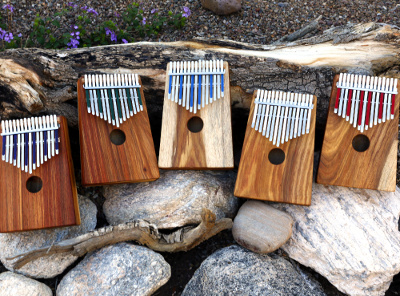
Since 1954, the Hugh Tracey kalimbas have come with selected tines painted. Why paint 1/3 of the tines? To help you keep your place on the kalimba, to interface the left notes with the right notes, and to help you translate notes from written kalimba tablature. If you follow the stories of the paired kalimbas in this photo collection, you will also realize that the painted tines can help you relate one kalimba to another. At Kalimba Magic, tine painting has become very important to us, and we paint them ourselves. When you purchase a kalimba, you can take the luck of the draw as to tine painting (blue is the most popular color, which we always have prepared), or you can choose from blue, green, black, white, red, or all unpainted tines.
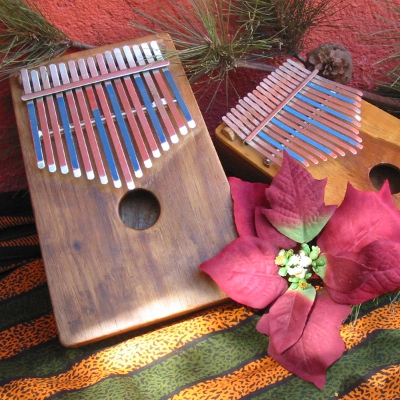
Originally, Hugh Tracey viewed the Treble as the primary instrument, with the Alto being a nice accompaniment instrument. Increasingly over the last 40 years, the Alto has taken main stage in the kalimba world.
In my recordings, the Alto often forms the meat of the song, and the Treble is added for beautiful frills.
Many of the instructional materials exist in similar forms for both the Alto and the Treble kalimbas. The Alto and Treble Fundamentals Books, the Hymnals, the Classical books, and the Advanced Christmas Carols books can, for the most part, be played with Alto and Treble together.
Our Sweetheart Deal is a discounted Alto and Treble Kalimba pair, both with pickups and a book for each kalimba, that can introduce you and a friend to the joys of two voices singing as one.
Go To Shop
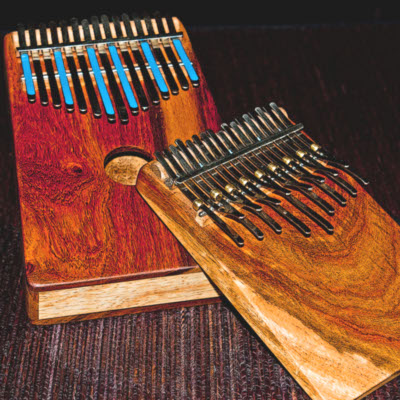 The Alto Kalimba has a range of exactly two octaves in the key of G, with G in the bass (the lowest note) and also G at the top. The African-Tuned Karimba, with a repertoire of traditional African music, also has a range of exactly two octaves, but is usually in A. A few things to consider: first, every traditional song that the African Karimba can play is, in principle, also accessible to the Alto kalimba, and these songs are available as instructional downloads. Second, if you want to play with another person, the Alto Kalimba and the African-tuned Karimba can actually play together – you can either tune the Alto up to A, or you can tune the Karimba down to G. Furthermore, the karimba tuning can be westernized to match the Alto’s notes, or the Alto’s tuning can be altered to match the African Karimba’s scale.
The Alto Kalimba has a range of exactly two octaves in the key of G, with G in the bass (the lowest note) and also G at the top. The African-Tuned Karimba, with a repertoire of traditional African music, also has a range of exactly two octaves, but is usually in A. A few things to consider: first, every traditional song that the African Karimba can play is, in principle, also accessible to the Alto kalimba, and these songs are available as instructional downloads. Second, if you want to play with another person, the Alto Kalimba and the African-tuned Karimba can actually play together – you can either tune the Alto up to A, or you can tune the Karimba down to G. Furthermore, the karimba tuning can be westernized to match the Alto’s notes, or the Alto’s tuning can be altered to match the African Karimba’s scale.
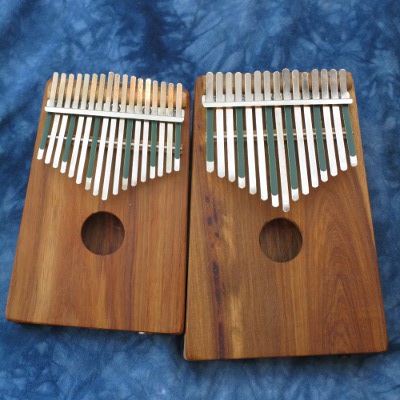
Here is another way, beside Sweethearts, that you can enjoy the Hugh Tracey Treble and the Alto Kalimbas together – this time as a matched pair. Both kalimbas are altered to make them easy to play together; every tine on the Treble is one octave above its corresponding tine on the Alto, until you get to the bottom two Treble notes, which have no analog on the Alto Kalimba.
Playing two instruments an octave apart can be very powerful; hearing music played in this interval sounds better than in unison, and harmonies between these two matched kalimbas are wonderful. Plus it’s a delight to echo what you can actually see and hear the other player doing, or to carry on a “conversation” between the two instruments. A lovely way to learn the magic of playing together with someone else.
Here is an example of the matched pair in action.
The Matched Pair can be tuned to the keys of G, F#, F, and E.
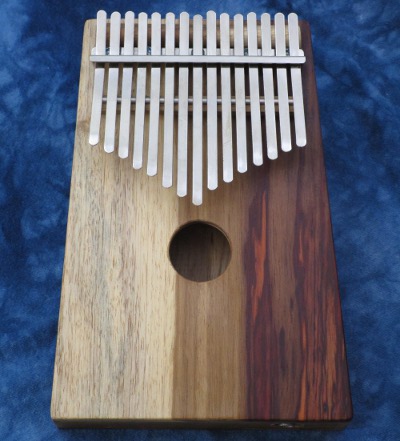
Every Hugh Tracey kalimba is mounted on a body made of kiaat wood. Kiaat is a native African hardwood tree, and is also known as “muninga”, among many other names. It grows in northern South Africa, in nearby Mozambique, and some areas in the Zambezi river basin. Hugh Tracey observed some traditional kalimbas that were made of kiaat, and of all the woods he experimented with, he liked this wood best. Furthermore, at that time he could purchase inexpensive scrap wood left over by furniture makers, who used kiaat wood for its durability. The heart wood of kiaat is usually a moderate to deep brown, and can have red highlights in it. The sapwood from the outer inch of the tree is blonde or yellow. Finally, there can be black lines accentuating the grain. Since every board cut from a kiaat log will have some sapwood at its outer edges, it is not uncommon to have a beautiful two tone kalimba, with both white or blonde sapwood and brown heart wood. At Kalimba Magic, before we ship, we always remove the kalimba from its cardboard box to check the wood, the pickup, and the tuning. We take the time to marvel at the gorgeous wood that chances to come to us. We then choose a paint color that will compliment the unique wood patterns, and paint the selected tines. We finish off by straightening up any tines that are out of place or not perfectly aligned, and perfecting the tuning.
And we make sure we thank the people in Africa who make these works of art, and help give them a sense of pride for the beautiful job they do in selecting wood for, and assembling, these exceptional instruments.
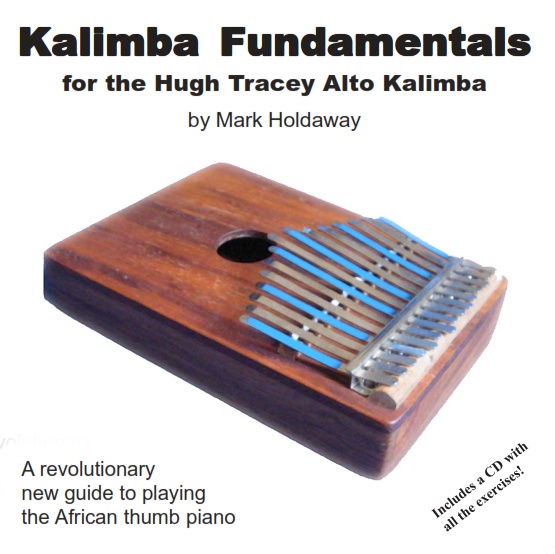 The Alto Fundamentals Book is a good introduction to the Alto kalimbas. The book also applies to the Bb Treble kalimba, the D Treble kalimba, and the front side of the G-tuned Chromatic kalimba. It covers technique, chords, scales, left-right exercises, some songs. 32 pages with CD. Purchase Book
The Alto Fundamentals Book is a good introduction to the Alto kalimbas. The book also applies to the Bb Treble kalimba, the D Treble kalimba, and the front side of the G-tuned Chromatic kalimba. It covers technique, chords, scales, left-right exercises, some songs. 32 pages with CD. Purchase Book
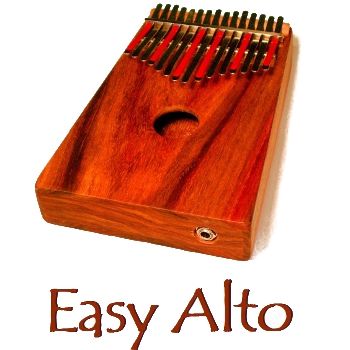 This easy-to-use tablature-based PDF e-book shows you how to get started with your Alto kalimba playing.
This easy-to-use tablature-based PDF e-book shows you how to get started with your Alto kalimba playing.
While this book starts at a very basic level, it accomplishes some cool things that will ease your kalimba playing in the direction of understanding and musical competency. Chords and arpeggios (chords one note at a time) are the easiest things to do on your Alto kalimba. Scales, which require crossing over, are the hardest things to do. We focus on both of these musical elements, and show you how to create some impressive music without a lot of work. Purchase Download
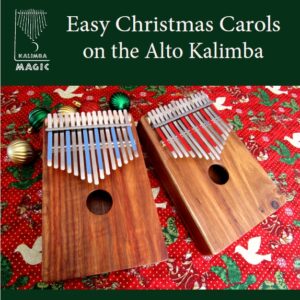 28 Christmas Carols for the 15-Note Alto Kalimba in G, tilted toward Level 1 and Level 2 arrangements, but with a few level 3 and 4 songs. Great for beginners!. Purchase Download
28 Christmas Carols for the 15-Note Alto Kalimba in G, tilted toward Level 1 and Level 2 arrangements, but with a few level 3 and 4 songs. Great for beginners!. Purchase Download
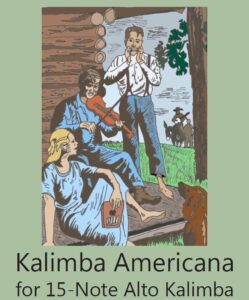 A single PDF download has tablature for 29 songs, with live links to the sound recordings. American classics arranged for ALTO Kalimba. Ranges from very easy to challenging. These are the songs we used to sing that brought our country together. We can still make music. Purchase Download
A single PDF download has tablature for 29 songs, with live links to the sound recordings. American classics arranged for ALTO Kalimba. Ranges from very easy to challenging. These are the songs we used to sing that brought our country together. We can still make music. Purchase Download
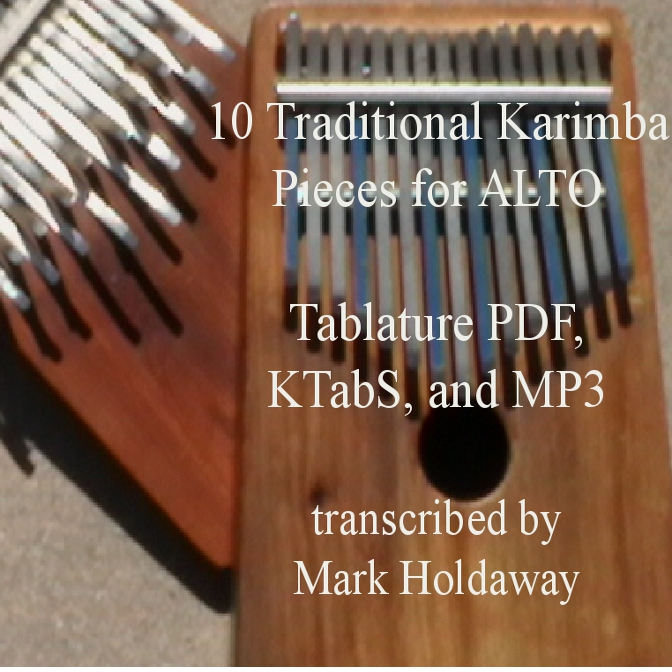 These 10 traditional African karimba pieces were given to Andrew Tracey and Paul F. Berliner through Jega Tapera, an African elder from Bulawayo, Rhodesia (now Zimbabwe), in the 1960s. The age of these pieces could be as much as 1000 years old. Arranged by Mark Holdaway for the Alto kalimba, they are provided in both KTabS and PDF format. MP3s of all the songs played in this download are provided to allow you to hear how the pieces go, even if you aren’t able to run KTabS on your computer. Available as download only. Purchase Download
These 10 traditional African karimba pieces were given to Andrew Tracey and Paul F. Berliner through Jega Tapera, an African elder from Bulawayo, Rhodesia (now Zimbabwe), in the 1960s. The age of these pieces could be as much as 1000 years old. Arranged by Mark Holdaway for the Alto kalimba, they are provided in both KTabS and PDF format. MP3s of all the songs played in this download are provided to allow you to hear how the pieces go, even if you aren’t able to run KTabS on your computer. Available as download only. Purchase Download
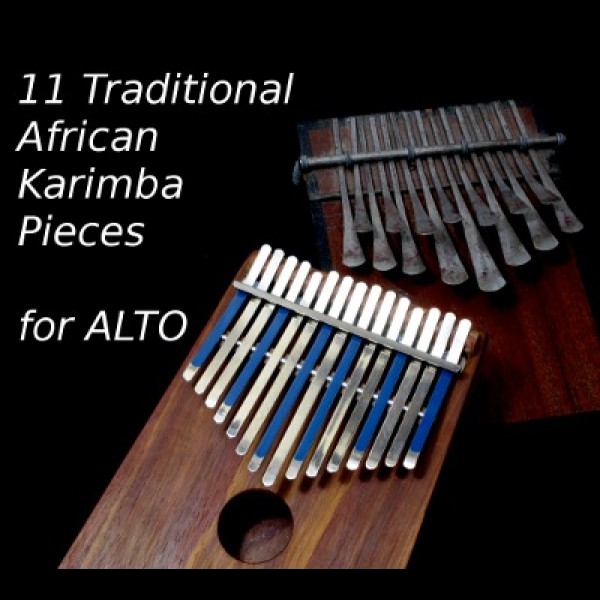
This download consists of a ZIP FILE containing tablature PDFs, KTabS files, and MP3s for each of 11 traditional African Karimba songs, arranged for the Hugh Tracey Alto Kalimba in G. These songs and their multiple variations were collected from the literature by Ivodne Galatea, with assistance from Mark Holdaway.
Important note: these songs were created on the African Tuned Karimba, also known as the mbira nyunga nyunga, and it is possible to play them on the Alto kalimba, but it is more challenging, and will require some special tricks – in other words, learning them will involve work, but these pieces should be worth the effort you put into them.
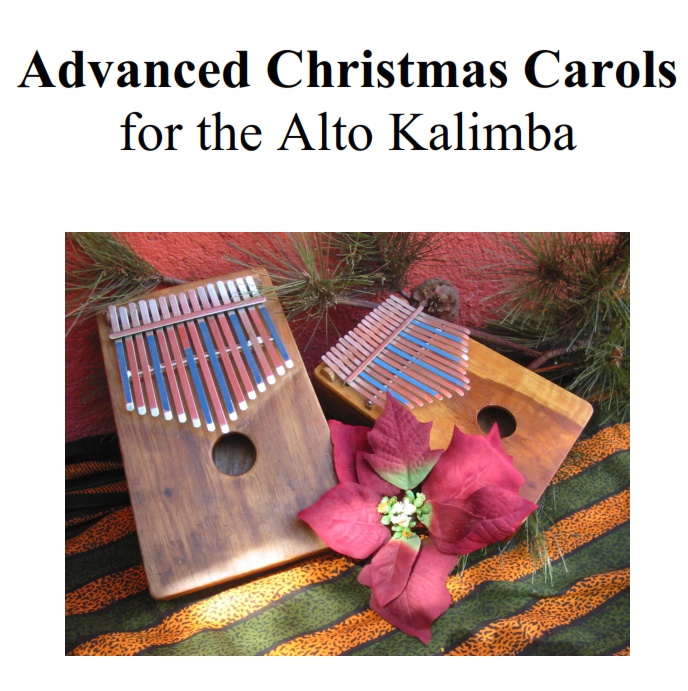 Arranged by Mark Holdaway, this collection is available as a
Arranged by Mark Holdaway, this collection is available as a
book or as a download. Both have 20 favorite Christmas Carols; the
download provides KTabS files, tablature PDFs, and MP3s of the songs played by KTabS, letting you hear how each piece goes, with or without the KTabS program. The arrangements here are very close to those I use when I perform these carols at Christmas time. Purchase Book
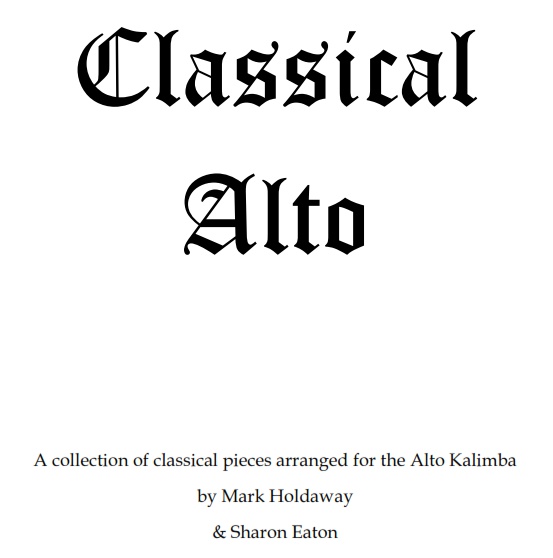 Arranged by Mark Holdaway and Sharon Eaton, this collection is available in book form or as a download from KTabS. Both have 20 favorite classical melodies, ranging from simple to very challenging. Including Bach, Handel, Holst, Pachelbel, and many others, this assamblage will keep you busy for months, if not years.Purchase Book
Arranged by Mark Holdaway and Sharon Eaton, this collection is available in book form or as a download from KTabS. Both have 20 favorite classical melodies, ranging from simple to very challenging. Including Bach, Handel, Holst, Pachelbel, and many others, this assamblage will keep you busy for months, if not years.Purchase Book
 Arranged by Sharon Eaton, this book has 50 hymns, ranging from simple to difficult. Amazing Grace, How Can I Keep From Singing, Jesus Loves Me, There is a Balm in Gilead, What a Friend We Have in Jesus, and 45 others.Purchase Book
Arranged by Sharon Eaton, this book has 50 hymns, ranging from simple to difficult. Amazing Grace, How Can I Keep From Singing, Jesus Loves Me, There is a Balm in Gilead, What a Friend We Have in Jesus, and 45 others.Purchase Book
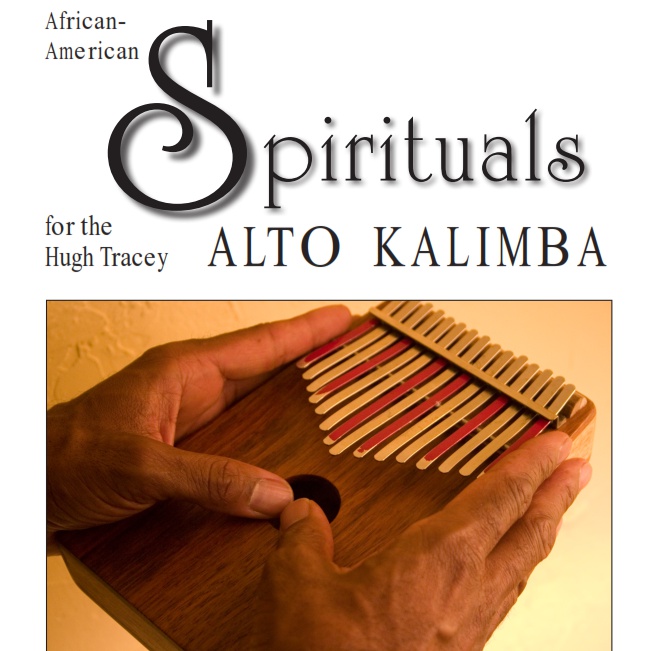 “African-American Spirituals”, arranged by Mark Holdaway, is available as both a book and as a download. There is documentation that the African kalimba was first brought to the New World by African slaves in the 18th century (evidence of kalimbas was found in Brazil and the Caribbean, also in New Orleans which is the only known North American site). The Alto kalimba was created by the Englishman Hugh Tracey, based on an ancient African instrument, with the objective of using the kalimba to play Western music and appeal to Western ears. The Alto kalimba is a unique composite of African and Western traditions, as indeed are African-American spirituals. The download is a PDF ebook with live links to sound files and the book comes with a CD. Purchase Book
“African-American Spirituals”, arranged by Mark Holdaway, is available as both a book and as a download. There is documentation that the African kalimba was first brought to the New World by African slaves in the 18th century (evidence of kalimbas was found in Brazil and the Caribbean, also in New Orleans which is the only known North American site). The Alto kalimba was created by the Englishman Hugh Tracey, based on an ancient African instrument, with the objective of using the kalimba to play Western music and appeal to Western ears. The Alto kalimba is a unique composite of African and Western traditions, as indeed are African-American spirituals. The download is a PDF ebook with live links to sound files and the book comes with a CD. Purchase Book
“Away in a Manger” – First learn the Easy Melody, then Add Chords. Voila!
Free Blank Tablature for Various Kalimbas – Updated and Expanded
Easy Christmas Carols – “God Rest Ye Merry, Gentlemen” on Alto
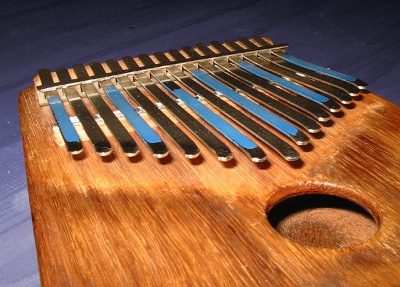 This is the old Alto Kalimba I have had for 25 years. Yours won’t look this old or beat up for some time, but with a bit of luck your Alto Kalimba will last this long and more. In my experience, the wood opens up over the first few years of playing, and they begin to sound really fine. Purchase Kalimba
This is the old Alto Kalimba I have had for 25 years. Yours won’t look this old or beat up for some time, but with a bit of luck your Alto Kalimba will last this long and more. In my experience, the wood opens up over the first few years of playing, and they begin to sound really fine. Purchase Kalimba
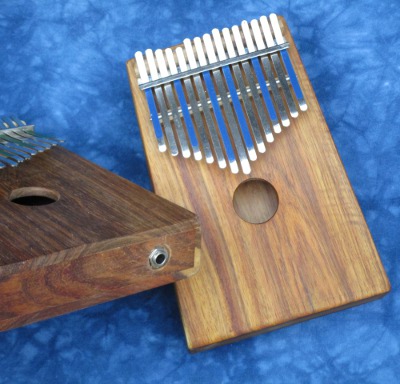 Since 2006, the Hugh Tracey kalimbas have been available with an optional electronic pickup. This passive pickup device is mounted on the underside of the face wood, near the bridge, and the signal is transmitted to the 1/4 inch jack on the foot of the kalimba. Using a standard 1/4 inch guitar cord, you can plug into an amplifier, an effects processor, a direct box, a mixer, or a PA system. For recording purposes, I greatly prefer the sound quality of a microphone to this inexpensive electronic pickup. On the other hand, the pickup allows you to play very loudly, so the kalimba can compete and show up well when playing with a loud band or with drummers. Purchase Kalimba
Since 2006, the Hugh Tracey kalimbas have been available with an optional electronic pickup. This passive pickup device is mounted on the underside of the face wood, near the bridge, and the signal is transmitted to the 1/4 inch jack on the foot of the kalimba. Using a standard 1/4 inch guitar cord, you can plug into an amplifier, an effects processor, a direct box, a mixer, or a PA system. For recording purposes, I greatly prefer the sound quality of a microphone to this inexpensive electronic pickup. On the other hand, the pickup allows you to play very loudly, so the kalimba can compete and show up well when playing with a loud band or with drummers. Purchase Kalimba
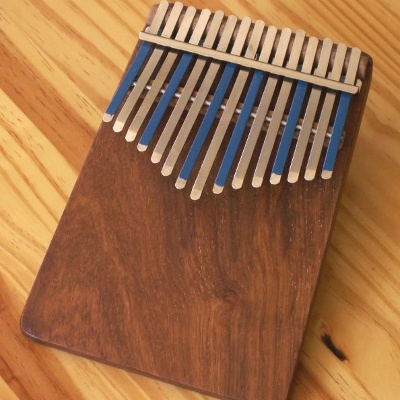 The Hugh Tracey Celeste Alto Kalimba, 15-notes, board mounted. This has the same notes as the box-mounted Alto Kalimba and reads the same Alto tablature and books. Purchase Kalimba
The Hugh Tracey Celeste Alto Kalimba, 15-notes, board mounted. This has the same notes as the box-mounted Alto Kalimba and reads the same Alto tablature and books. Purchase Kalimba
 The C-Alto is the exact same instrument as the Hugh Tracey Alto Kalimba, but tuned to C. The range is still the same as the standard Alto – two octaves starting with G below middle C. In other words, G, or the 5th of C, is in the bass. I put black dots on the two C tines to remind me that they are the root notes – or the “1” of the scale. Having the “5” of the scale in the bass is particularly useful for a large body of songs. Plus, I can play this one with my marimba band. Purchase Kalimba
The C-Alto is the exact same instrument as the Hugh Tracey Alto Kalimba, but tuned to C. The range is still the same as the standard Alto – two octaves starting with G below middle C. In other words, G, or the 5th of C, is in the bass. I put black dots on the two C tines to remind me that they are the root notes – or the “1” of the scale. Having the “5” of the scale in the bass is particularly useful for a large body of songs. Plus, I can play this one with my marimba band. Purchase Kalimba
There are many other tunings for the Hugh Tracey Alto Kalimba, but I recommend that you start with the standard G major tuning. Most of the tips, tablature, and books were written for the standard tuning, so a good path to follow is to keep your kalimba in the key of G for a year or two or three as you learn, and then branch out into other tunings as you progress.
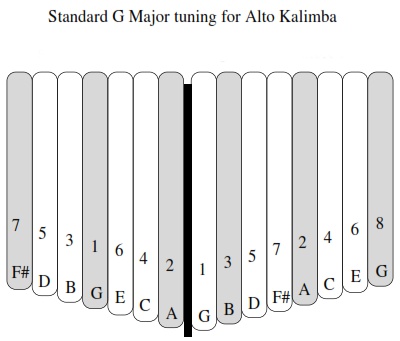
The Hugh Tracey Alto Kalimba’s standard tuning comprises two octaves of the G major scale. The lowest and highest notes are both G, which is the root note, making this tuning easy to understand. Furthermore, there are tons of books and downloads that work with this tuning. The A, Ab, G, F#, F, and E tunings are all basically the same pattern, all with the root note at the bottom and the top notes – hence they can all read the same tablature and use the same books. Why would you want another key other than G? If you don’t know, stick with G tuning.
The letters on the tines in the diagram are the names of the notes each tine is tuned to. The numbers are the degree of the scale – that is, 1, the root note, is “Do” as in “Do, Re Mi, Fa, So”. The number 5? count up, 1, 2, 3, 4, 5, which would be “Do, Re, Mi, Fa, So”. Of course, 8 is the “Do” at the top of the scale, and is the same note name as the bottom “Do” of the scale – that is, 1 and 8 are the same note. The “Do, Re, Mi…” scale is synonymous with the major scale, which is the standard reference for all other scales. Some other scales will have lowered versions of some of the degrees of the scale – a minor 3rd is a lowered, or flattened (taken down a half step) 3rd, and we refer to it as “3-“. Some scales have raised or sharpened (raised a half step) versions of some of these notes, and we indicate them with a plus sign, as in “4+”. And some scales will completely skip some degrees of the scale – the major pentatonic scale skips the 4 and the 7. Stick around, and you’ll learn a lot about music through the little kalimba.

Maurice White of Earth, Wind, and Fire used a 17-Note Treble Hugh Tracey kalimba tuned to an A minor pentatonic scale with redundant notes, wowing people on songs such as Evil and Kalimba Story during the 1970s. The tuning on our Evil Alto kalimba is analogous to the tuning of Maurice White’s Treble kalimba.
In the tablature diagram, the painted tines in the middle of the left side and the middle of the right side are both tuned to A notes, and the next lower tines on both sides are tuned to G notes. This novel tuning permitted Maurice to perform a fast trill on either of those notes by alternating quickly between the left and right versions of either the A or the G, twice as fast as you could trill any single note played on just one side.
The lowest note is the “7-” or flat 7, also known as a minor 7, and it leads into the root note, A = 1. Other notable features are the minor 3rd or “3-“, and the missing 2 and 6, and the root note A at both the top right and the top left.
This type of scale came out of the work of Chicago jazz musician Phil Cohran, who employed an electric kalimba with a similar tuning when he recorded with Sun Ra in the 1960s. Part of the draw of this scale is its distinct African “feel” – one of Hugh Tracey’s research findings was that about 40% of traditional African kalimba tunings use a pentatonic scale like this one. Phil Cohran inspired Maurice White with his use of the kalimba as a symbol of Africa, the pentatonic scale to represent African music, as well as his use of those redundant notes in building musical excitement.
Coming soon: Evil Alto Sound Recording
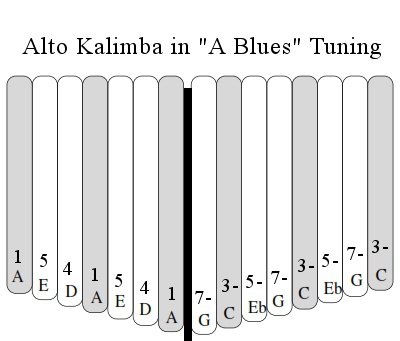
There are actually several “blues scales”. I’ve known about this type of blues scale for 40 years. It is almost exactly the same as the minor pentatonic scale, and it would go great with the Maurice White Evil Tuning. It has an extra note thrown in, the Eb, between the 4 and the 5 in each octave. You can think of it as a raised 4 or “4+” or as a flat 5 or “5-“. In contrast to the Evil tuning, this one does not have any redundant notes. In this tuning a C is added at the very top, with two “5-” notes, the Eb’s that are both on the right side. In the language of the blues, the “5-” note is also called the “blue note”; in the classical world, the “tritone”; in medieval times it was called the “devil’s interval” and its use was forbidden by the Church!
This is not the same tuning Kevin Spears uses, but it is quite similar in nature.
Coming soon: recording of the Alto A minor Blues Tuning.
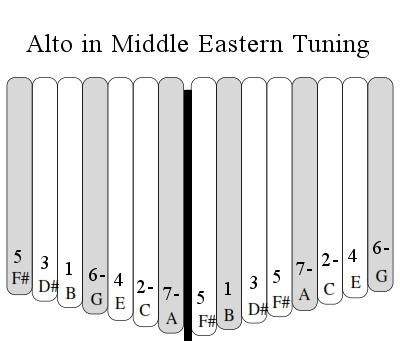 The Middle Eastern tuning was my first alternative tuning, in 2001 of all times. This tuning reminded me of a simple truth: even though my country was at war with people in the Middle East, I could still extend honor and love to the people of the Middle East and their culture and their art. It helped me to love in a hard time.
The Middle Eastern tuning was my first alternative tuning, in 2001 of all times. This tuning reminded me of a simple truth: even though my country was at war with people in the Middle East, I could still extend honor and love to the people of the Middle East and their culture and their art. It helped me to love in a hard time.
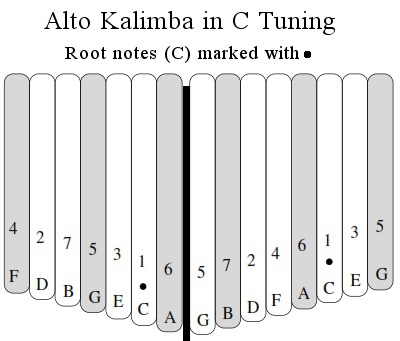
There are two broadly different ways of changing the key of your kalimba. One way is by retuning all the tines in the same way (i.e., pulling out every tine by a half step, which will retune the standard Alto kalimba from G down to F#). The other way is to retune around the circle of 5ths, changing just one note per octave will transform both the key and the note layout of the instrument. An example of this is going from the Alto’s standard G tuning to the C tuning shown here. The two F# tines are retuned a half step down to F, and the root note becomes C.
Why would one want to change an Alto kalimba to C from G tuning? Three reasons come to mind: (1) you might need to play kalimba in the key of C to accompany a vocal song for it to be in your vocal range, (2) you can play similar music but in a significantly different range with respect to the root note, enabling you to potentially play a lot of different music and (3) you might need to play in the key of C to play with other musicians – I use my C-tuned Alto to play with my marimba band Baba Marimba.
Here’s the best thing about the C-tuned Alto Kalimba: this is one of the easiest retunings, so you can do it yourself.

The G minor tuning is conceptually very close to the standard G major tuning. Every note that is present on the standard G Alto is also on this kalimba in the same place with the same letter, but the F# is now F (F also called F natural), the B is now Bb (B flat), and the E is now Eb. (By the way, these are the same basic changes that must occur to turn a G Treble into a Bb Treble.)
It is instructional to compare the G Major tuning with the G minor tuning. The root (1), the 5th, the 2nd, and the 4th, i.e., the most important notes for chord progressions in any particular key, are the same for G minor as for G Major. The G minor tuning has a flat or minor 7th (designated as 7-), a flat or minor 3rd (3-), and a flat or minor 6th (6-). The notes that are changed in this retuning do cause a pronounced change in the emotional flavor of the scale.
Why would you want this tuning? To more completely understand and experience the minor key, with the psychological advantage of having the root note of the minor key in the bass. G minor also goes with Bb major, so this would be a good kalimba to play with the Bb Treble.
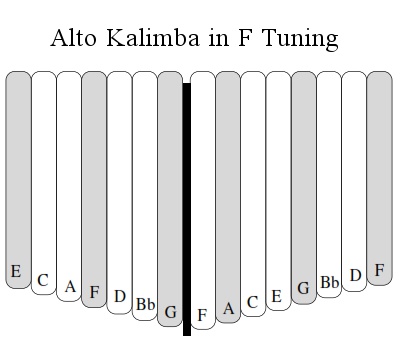 The F tuning is made from the G tuning by simply tuning every note down by a whole step. The role each tine plays in this scale – that is, the 1, the 5, etc., do not change, so anything you learned on the G Alto will be easily played on this tuning, just a step lower. And unless you have perfect pitch, you won’t even realize this instrument is different from the G Alto, since it seems to play just the same as the standard G tuning.
The F tuning is made from the G tuning by simply tuning every note down by a whole step. The role each tine plays in this scale – that is, the 1, the 5, etc., do not change, so anything you learned on the G Alto will be easily played on this tuning, just a step lower. And unless you have perfect pitch, you won’t even realize this instrument is different from the G Alto, since it seems to play just the same as the standard G tuning.
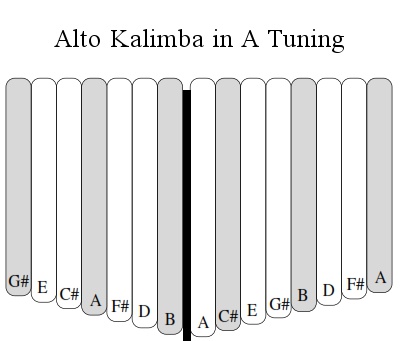
To tune to A major, every tine on a standard-tuned G Alto is pushed in just enough so that the whole instrument rises a whole step in pitch. Just as with the F Alto, unless you have perfect pitch you will not really even realize this kalimba is different from the G-tuned Alto. Every song you play on the standard G Alto can be played on this kalimba, it will just sound a step higher.
In addition to F, G, and A, the Alto kalimba can also be tuned to E, F# (Gb), and G# (Ab). Why don’t more people get their Altos tuned down to E, a great key in which to play along with guitar? The body size of the Alto is designed to resonate down to the low G note, but it starts to lose resonance at F#, more in F, and more still in E. You can compensate for this by playing in a gourd or on a table – a larger resonant structure that will help amplify the lower notes. Playing through a pickup also helps with the reproduction of notes from the low range of the kalimba.
If you have any questions, feel free to contact us via the email form, or speak directly to Mark Holdaway at 520-488-7641. Contact Us


Sign up for our newsletter and free resources with your email address:
We pinky promise not to spam you and to only send good stuff.
 Assist Paul Tracey Rebuild His House in Pacific Palisades
Assist Paul Tracey Rebuild His House in Pacific Palisades 8-Note Spiral Kalimba Turned into a Student Karimba
8-Note Spiral Kalimba Turned into a Student Karimba Seek to Infuse Your Musical Moments With Beauty and Magic
Seek to Infuse Your Musical Moments With Beauty and MagicUse of this website constitutes acceptance of the Privacy Policy and User Agreement. Copyright © 2020 Kalimba Magic. All Rights Reserved.